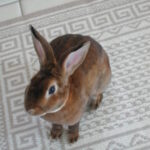Rabbits require special care during the summer as they have a thick coat of fur that leads to overheating, dehydration, and other health related problems. Having owned a rabbit for 8-years, I have successfully litter box trained and house trained him, as well as dealing with eight summers in a warm climate. This article will look at six tips for properly taking care of your rabbit during the summertime.
1. Molting
During the early summer months, rabbits go through a phase called molting, where they lose their thicker winter coat in place of a thinner summer coat of fur. Molting is a way for rabbits to stay cool during the summer. However, the process leaves lots of hair in the rabbit’s cage and anywhere they play. The problem with hair is that rabbits will get it in their food and water supply, which can lead to hairballs.
2. Dealing with summertime hairballs
The rabbitry that I purchased my rabbit at told me that hairballs are a leading cause of death among her rabbits because rabbits do not have a natural ability to digest their own fur or cough it up. Rabbits that eat too much of their own fur will refrain from eating and drinking, which causes death. However, using an acidic fruit such as pineapple juice is a great way to break down the hairball. Rabbits with a hairball problem do not like to drink pineapple juice. Therefore, I recommend using a baby medicine droplet applicator as it can easily fit into the rabbits’ mouth.
3. Keep the rabbit cool
Rabbits can have problems from being overheated in the summertime, especially if they are outdoor rabbits. Try building a small hutch for the rabbit to take shelter in during the summer, or bring the rabbit into the house during unbearably hot days.
4. Water
Rabbits consume more water during the summer months; therefore, it is vital to check the rabbits’ water supply regularly. Remember to refill the water bottle that the rabbit drinks out of to insure they are getting enough water during the day.
5. Look for warning signs of overheating
My rabbit would pant and make noises when he would get overheated, which meant he needed shade quick. Although he lived inside, he would still suffer from the heat. In order to fit his needs we would bring an AC unit into his room, or place him in a room with AC. If the rabbit is an outdoor rabbit you should cover the part of the cage that is exposed to sunlight with a light sheet or tarp, but remember to keep part of the cage free for ventilation as the rabbit still needs air to breathe.
6. Place a cool wet towel in the cage
Rabbits inherently hate to take bathes (similar to cats); however, if you place a cool wet towel in their cage they will lay on it to cool off. I recommend changing and washing the towel regularly, as it will become dirty from staying in the cage more than one day.
Sources:
Personal experience as a rabbit owner






